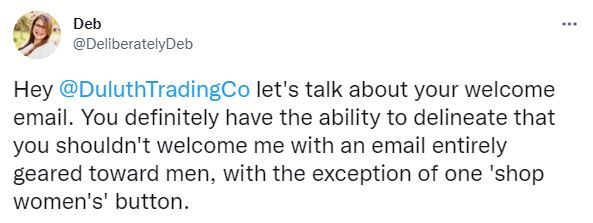Ever get annoyed when you open an email and the first thing you see doesn’t apply to you? I had this exact experience a few months ago when I signed up for Duluth’s emails during the checkout process, and the “welcome” email was entirely geared toward men (even though my purchase was women’s clothing):

This annoyance could have easily been prevented with email segmentation. Even in the “cheapest” of systems, you can segment your subscribers by data like location, type and amount of campaign engagement, activity, interests, and more.
“But Deb, my email list isn’t very big. If we build some of these segments, they might be pretty small.”
Small email segments are a-okay. While we certainly want to balance the workload with the potential positive impact, an email strategy for a well-segmented list can be the definition of “small but mighty”.
In addition to avoiding customer annoyance, the following are three reasons to always build out email segments, even if they’re small.
1. Segmented campaigns help you build trust
Humans like to be paid attention to. We like to feel as though we’re being taken into consideration by others, and that includes by the brands that we choose to give our money to. Ensuring that you’re delivering the appropriate message to the appropriate audience nurtures the customer-brand relationship and helps you build trust. Put yourself in your customer’s shoes and think, “Does this message make me feel cared about and paid attention to, or does it just yell “please keep spending money here”?”
Segmenting a campaign based on location, for example, is a simple-but-effective way to ensure your customers feel like you’re paying attention to them (ya know, don’t send the Philly list the “yinz” email, right?).
2. Segmented campaigns get more opens and clicks
When you stop to think about it, it makes perfect sense that sending relevant emails increases open and click rates, right? A 2017 Mailchimp global review of 11,000 emails sent to almost 9 million segmented recipients shows a 14.31% higher open rate and a staggering 100.95% higher click rate than non-segmented campaigns. As an added bonus, the unsubscribe rate for those emails was also 9.37% lower than non-segmented campaigns. I believe we call that a “win-win-win”.
3. Segmented campaigns give you information that can inspire all new ways to serve your customers
Now that you’ve built trust with your customers and increased the open and click rates using segmented lists, let’s take a look at the data. What are the folks in Segment A doing with your email? Is there a common thread in what they’re doing on your website once they get there? This information can inspire ideas for new products, services, campaigns, and more:
- Maybe your customers are getting to the site from an email and dropping off two pages in. What are we missing that we can get them closer to a point of purchase?
- Perhaps the customers are clicking through to the site and immediately bouncing. Is the load time too slow? Did they expect to land somewhere closer to the purchase point?
- It’s possible that the amount of information a customer needs to make a purchase is too much for the landing page. Let’s follow-up with a blog that solves that information gap, further builds their trust in your brand, and moves the customer closer to the purchase.
All of these great email marketing benefits from simple list segmentation. Not sure where to start with segmenting your lists? Send me an email – a segmentation consult is only a conversation away.
PS – Duluth did respond to the tweet, which I appreciated.



